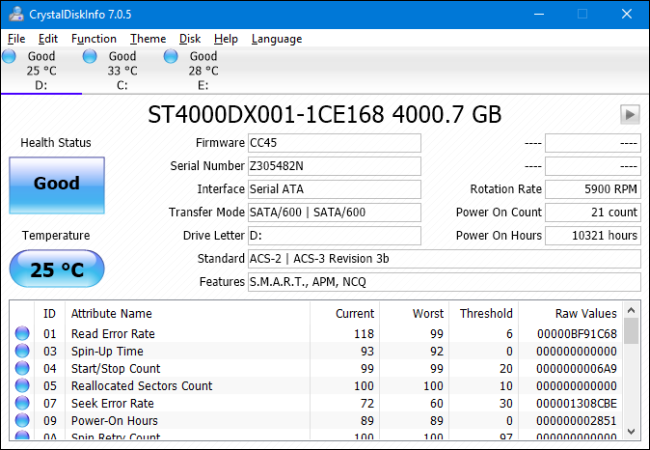How to see if your hard drive is dying with S.M.A.R.T. (SMART)
Hard drives use S.M.A.R.T. (Self-Monitoring, Analysis, and Reporting Technology) to gauge their own reliability and determine if they’re failing. You can view your hard drive’s S.M.A.R.T. data and see if it has started to develop problems.
Hard drives don’t live forever, and you often can’t see the end coming. Fortunately, most modern drives support S.M.A.R.T., so they can at least do some basic self-monitoring. Unfortunately, Windows doesn’t have an easy-to-use built-in tool that shows your hard disk’s S.M.A.R.T. data. You can view a very basic S.M.A.R.T. status from the Command Prompt, but to really see this information, you’ll need to grab a third-party app.
Check S.M.A.R.T. Status with CrystalDiskInfo
CrystalDiskInfo (free) is an easy-to-use, open-source program that can shows the S.M.A.R.T. status details reported by your hard drives. You can download an installable or portable version—the choice is up to you.
Once you’ve got CrystalDiskInfo running, it’s a pretty straightforward app. The main view shows the S.M.A.R.T. status information for your hard drives. If everything is working properly, you should see the status “Good“ displayed. In the image below, just under the menu bar, you can see that all three drives in our system report a “Good” status and you can even view the temperature of each drive. Other statuses you might see include “Bad” (which usually indicates a drive that’s dead or near death), “Caution” (which indicates a drive that you should most likely be thinking about backing up and replacing), and “Unknown” (which just means that S.M.A.R.T. information could not be obtained).

You can also view a list of detailed information about each drive, but unless you’re a pro—or you’re troubleshooting something very specific—it likely won’t mean much to you. If you’re interested, though, the Wikipedia page for S.M.A.R.T. maintains a pretty good list of these attributes, along with how they can be interpreted.
There’s really not a lot more to the app, but there is one other feature worth pointing out. If you are particularly concerned about the health of a drive, you can set CrystalDiskInfo to start with Windows and run as a background app. While it’s running this way, CrystalDiskInfo will send a notification to alert you if the S.M.A.R.T. status of any drive changes. Just open the “Function” menu and toggle both the “Resident” and “Startup” options on.

Check S.M.A.R.T. Status at the Command Prompt
You can also view a very basic S.M.A.R.T. status from the Windows Command Prompt. To open the Command Prompt, hit Start, type “Command Prompt,” and then press Enter.

A the prompt, type (or copy and paste) the following command, and then press Enter:
wmic diskdrive get status
If everything is working properly, you should see the status “OK” displayed for each hard drive on your system. Other statuses—such as “Bad,” “Caution,” or “Unknown”—can indicate problems with your drive or errors retrieving S.M.A.R.T. information.
Help, My Hard Drive Is Dying!
If the S.M.A.R.T. status indicates that you have an error, it does not necessarily mean that your hard drive is going to fail immediately. However, if there’s a S.M.A.R.T. error, it would be wise to assume that your hard drive is in the process of failing. A complete failure could come in a few minutes, a few months, or—in some cases—even a few years. However long it takes, you should not trust the hard drive with your data in the meantime.
Ensure you have up-to-date backups of all your files stored on another media, such as an external hard drive or optical discs. Obviously, this is good advice whether you know the S.M.A.R.T. status of your drives or not. Problems—including drive failure—can happen at any time, and without warning. With your files properly backed up, you should look into replacing your hard drive as soon as possible. You simply cannot consider a hard drive that fails a S.M.A.R.T. test to be reliable. Even if your hard drive doesn’t die completely, it could corrupt portions of your data. You might also consider using the chkdsk tool in Windows to diagnose and repair any related problems that it can.
Related Articles
How to format your secondary hard disk in Windows
If you’re installing a new hard drive, or need to wipe your drive clean for that “fresh” feeling, you’ll end up formatting your drive. Formatting will check the drive for errors, and prepare it for use. If a drive has data on it, formatting the drive ...How to Set Up Software RAID 1 on an Existing Linux Distribution
What is RAID? RAID stands for Redundant Array of Inexpensive Disks. RAID allows you to turn multiple physical hard drives into a single logical hard drive. There are many RAID levels such as RAID 0, RAID 1, RAID 5, RAID 10 etc. Here we will discuss ...How to change the location of your Documents in Windows 10
Whenever you save a new file in Windows 10, the Save As window defaults to whichever of your user folders–Documents, Music, Pictures, and so on–is appropriate to the file type. If you’d rather not save files on the C: drive, though, Windows lets you ...How to install Windows from USB / DVD
(Image: © TechRadar) Looking to figure out how to install Windows 10 via USB or DVD? Well, you’ve come to the right spot. Windows 10 has been around for a while now, with Microsoft bringing in a number of welcome improvements to the table. And, if ...How to create/move your Steam Library
Today’s games are unapologetically massive. In the old days, game sizes were limited by their respective medium. With the advent of broadband internet and digital downloads, though, games have transcended physical mediums and grown exponentially in ...
